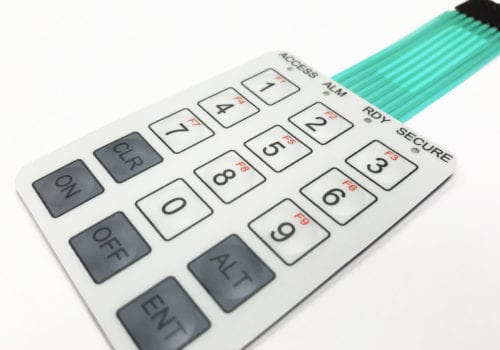Discover How a Membrane Switch Boosts Toughness and Capability in Devices
Discover How a Membrane Switch Boosts Toughness and Capability in Devices
Blog Article
Recognizing the Functionality of Membrane Layer Switches for Individual User Interface Gadget
The performance of membrane switches represents a considerable innovation in user interface style, combining effectiveness with aesthetic adaptability. These buttons run via a multi-layered framework that converts user communications right into electric signals, permitting both small layouts and strength against ecological elements. As sectors progressively prioritize customer experience, comprehending the subtleties of membrane button innovation comes to be crucial. What implications do these developments hold for future applications, and how might they redefine customer communications across various gadgets?
What Are Membrane Switches?
Membrane layer buttons are cutting-edge user interface devices that help with user interaction with electronic devices. These flexible parts contain numerous layers, consisting of a visuals overlay, spacer, and a published circuit layer. The design allows for a seamless integration into different electronic gadgets, improving both the visual and practical elements of interface.
Membrane layer buttons are generally used in a vast array of applications, from home home appliances to industrial machinery and medical devices. Their building normally includes a slim account, making them an ideal choice for compact designs. The tactile feedback supplied by these buttons can be crafted to satisfy certain individual choices, ensuring reliable interaction in between the user and the device.
Durability is an additional substantial advantage of membrane buttons, as they are immune to dust, moisture, and chemicals, which boosts their life-span popular environments. In addition, these buttons can be personalized in terms of form, dimension, and graphic layout, permitting branding and user-specific functions. In general, membrane switches over stand for a functional service for enhancing individual experience in digital devices, combining performance with aesthetic appeal in an effective fashion.
Just How Membrane Layer Changes Work
Operating on a straightforward concept, membrane switches over utilize a split construction to sign up user input successfully. Each button includes multiple layers, consisting of a printed circuit layer, a spacer layer, and a leading visuals layer, which are developed to interact effortlessly. When a user presses the top layer, it presses the spacer layer, bringing the conductive elements of the circuit layer right into call with each other.
This get in touch with develops a closed circuit, indicating the tool to perform a details function. The style permits for various setups, consisting of responsive feedback, which can improve the customer experience by providing a physical feeling upon activation. The products made use of in membrane switches commonly consist of flexible substrates, such as polyester or polycarbonate, which make sure resilience and durability versus damage.

Key Advantages of Membrane Switches

One more substantial advantage is their density. Membrane buttons are thin and light-weight, which allows manufacturers to conserve space in their tools without compromising functionality. This attribute is especially useful in applications where weight and volume are essential factors to consider.
Additionally, membrane layer switches are resistant to dust, dampness, and chemicals, improving their resilience. This strength prolongs their life-span and decreases the demand for frequent their website substitutes, resulting page in expense savings gradually.
Moreover, the tactile responses offered by membrane layer switches can be enhanced to boost user interaction. They can consist of features such as increased switches or audible clicks, enhancing use and individual experience.
Applications Throughout Industries
Interface tools utilizing membrane layer buttons are prevalent in a large array of markets, showcasing their flexibility and functionality. Membrane Switch. In the clinical field, membrane buttons are integral to tools such as diagnostic devices and client surveillance systems, where their durability and ease of cleaning are vital for preserving health criteria. In the vehicle sector, these buttons are used in control panel controls and infomercial systems, giving a sleek and modern user interface for customers.
Additionally, the customer electronic devices market gain from membrane layer buttons in home appliances and handheld gadgets, where compact design and easy to use user interfaces improve individual experience. Industrial applications likewise leverage membrane switches for control panels in equipment and automation systems, stressing their effectiveness and resistance to extreme settings.
In the aerospace and protection sectors, membrane layer switches are utilized in cockpit controls and equipment, where integrity and efficiency under severe conditions are extremely important. Furthermore, the gaming sector increasingly includes membrane buttons in controllers and arcade devices, contributing to an interesting user experience. On the whole, the convenience of membrane layer switches enables their prevalent use across countless sectors, highlighting their value in contemporary individual interface design.
Future Fads in Membrane Switch Over Modern Technology

Additionally, using innovative materials, such as polycarbonate and polyester Continued films, is anticipated to climb, giving boosted sturdiness and resistance to environmental stress factors. These products add to the general durability of membrane layer switches, making them ideal for harsher industrial applications.
In addition, the unification of wise modern technology, consisting of IoT connectivity, will certainly allow membrane layer switches to connect with other devices and systems, helping with an extra interactive user experience. This trend lines up with the expanding need for clever devices across different sectors, from health care to customer electronic devices.
Last but not least, modification options are anticipated to expand, allowing manufacturers to produce bespoke services tailored to specific user needs and preferences. These advancements will position membrane switches as important components in the evolution of user interface technology.
Conclusion
To conclude, membrane layer changes stand for a critical development in user interface innovation, offering a dependable and versatile remedy for varied electronic applications. Their split building helps with compact style, while features such as responsive comments enhance customer interaction. The resilience versus ecological factors better solidifies their energy across multiple markets. As developments in product science and touch picking up innovations continue, the performance and applicability of membrane switches are anticipated to broaden, enhancing their relevance in modern electronic tools.
Report this page